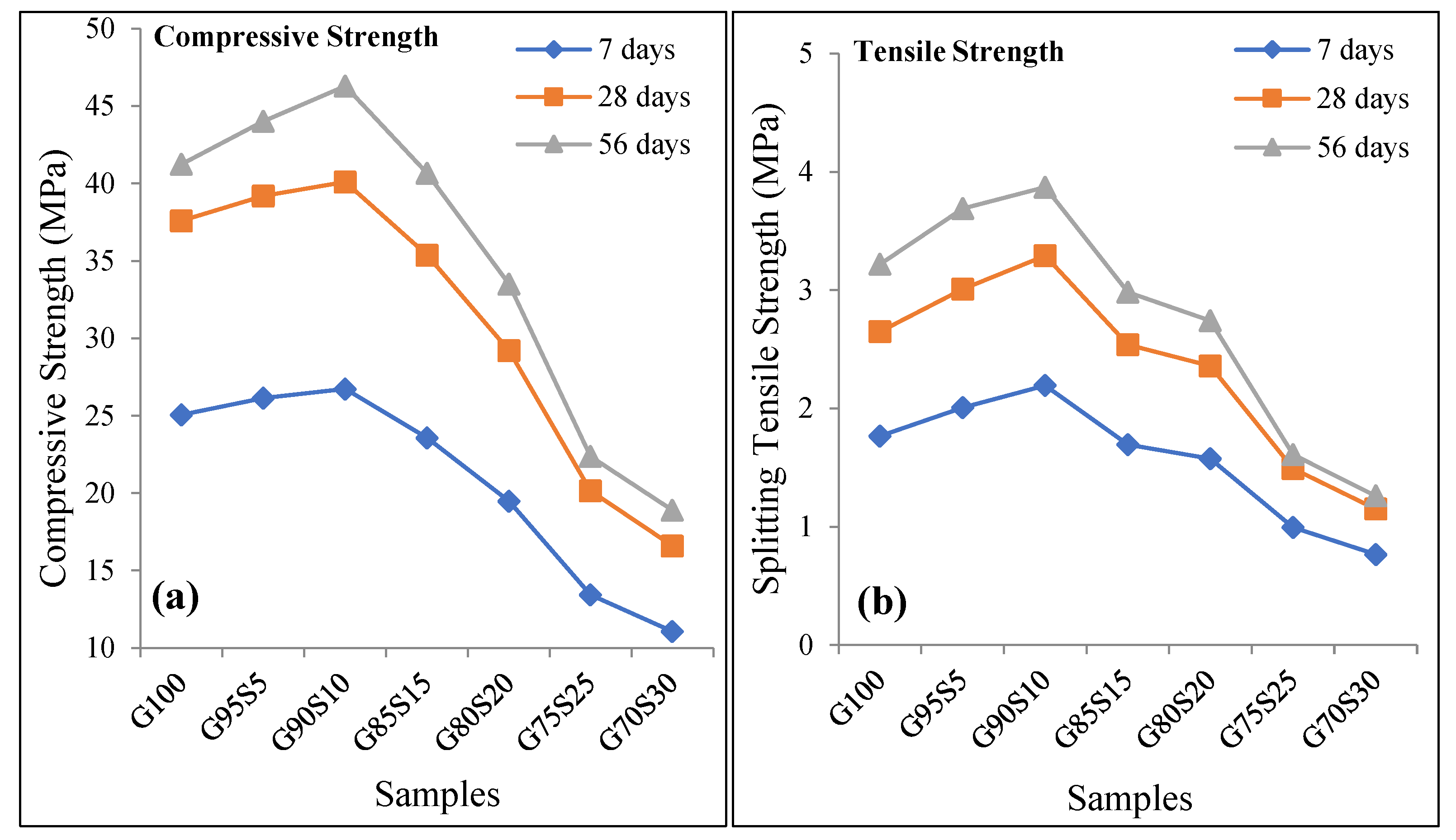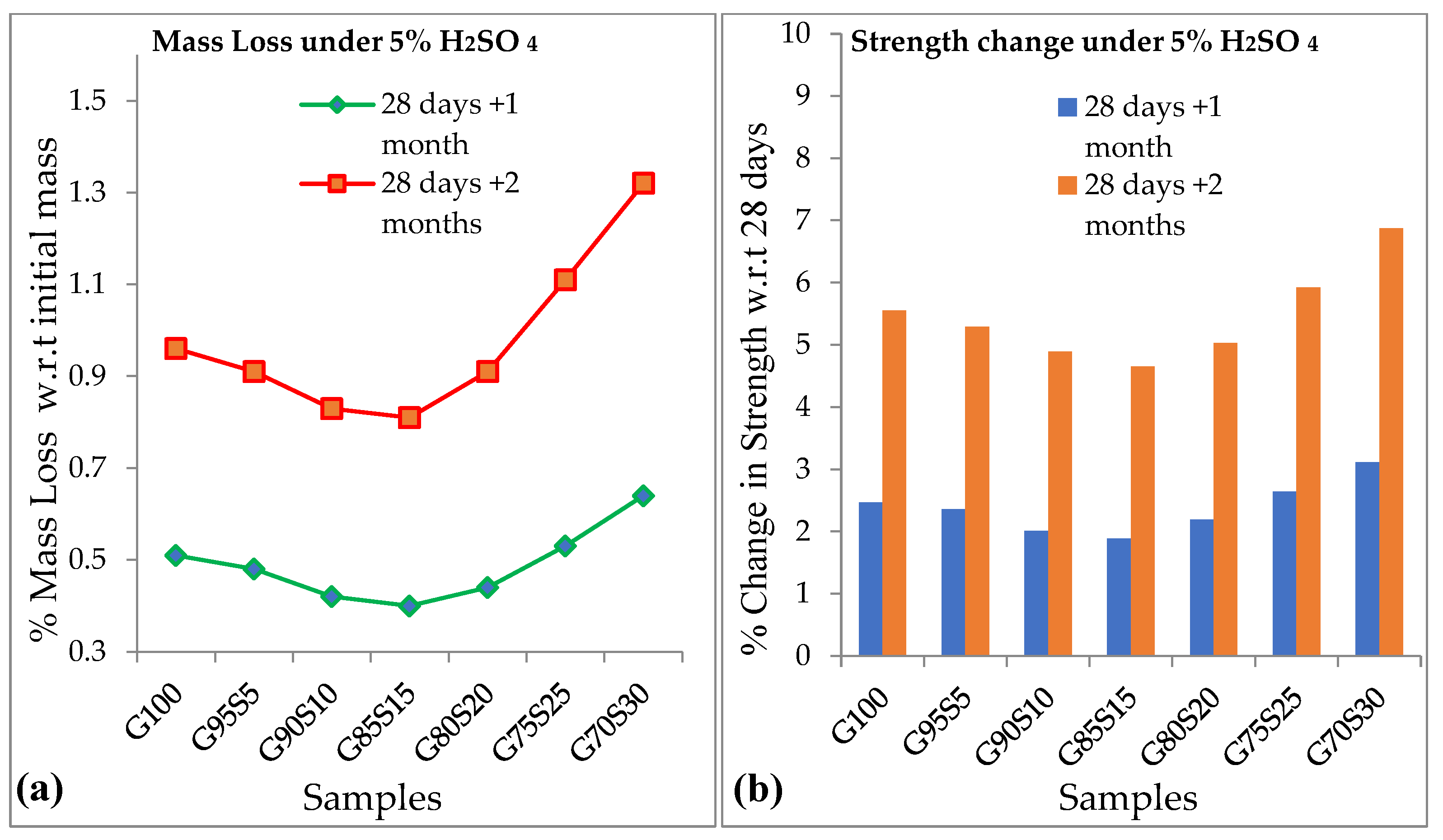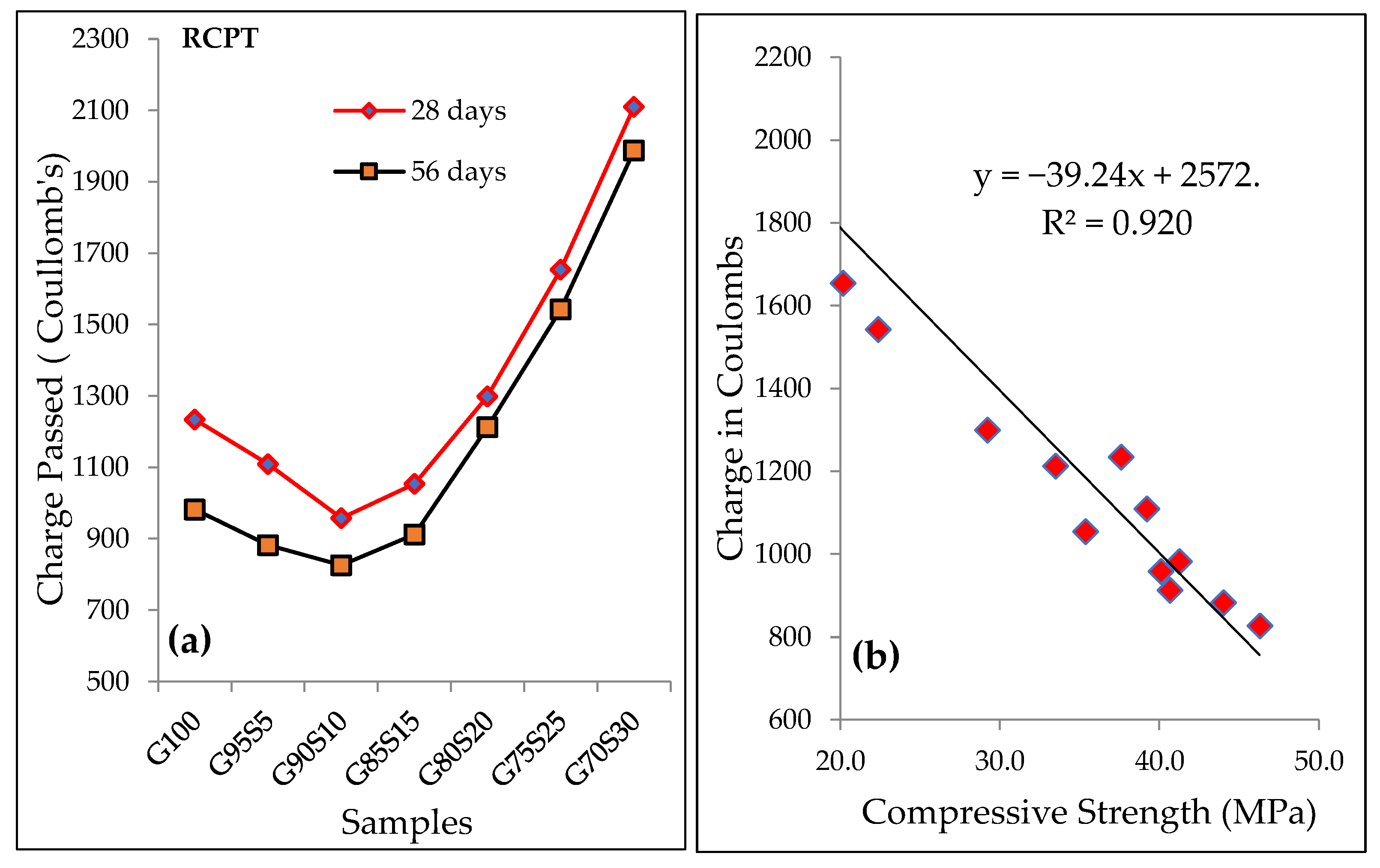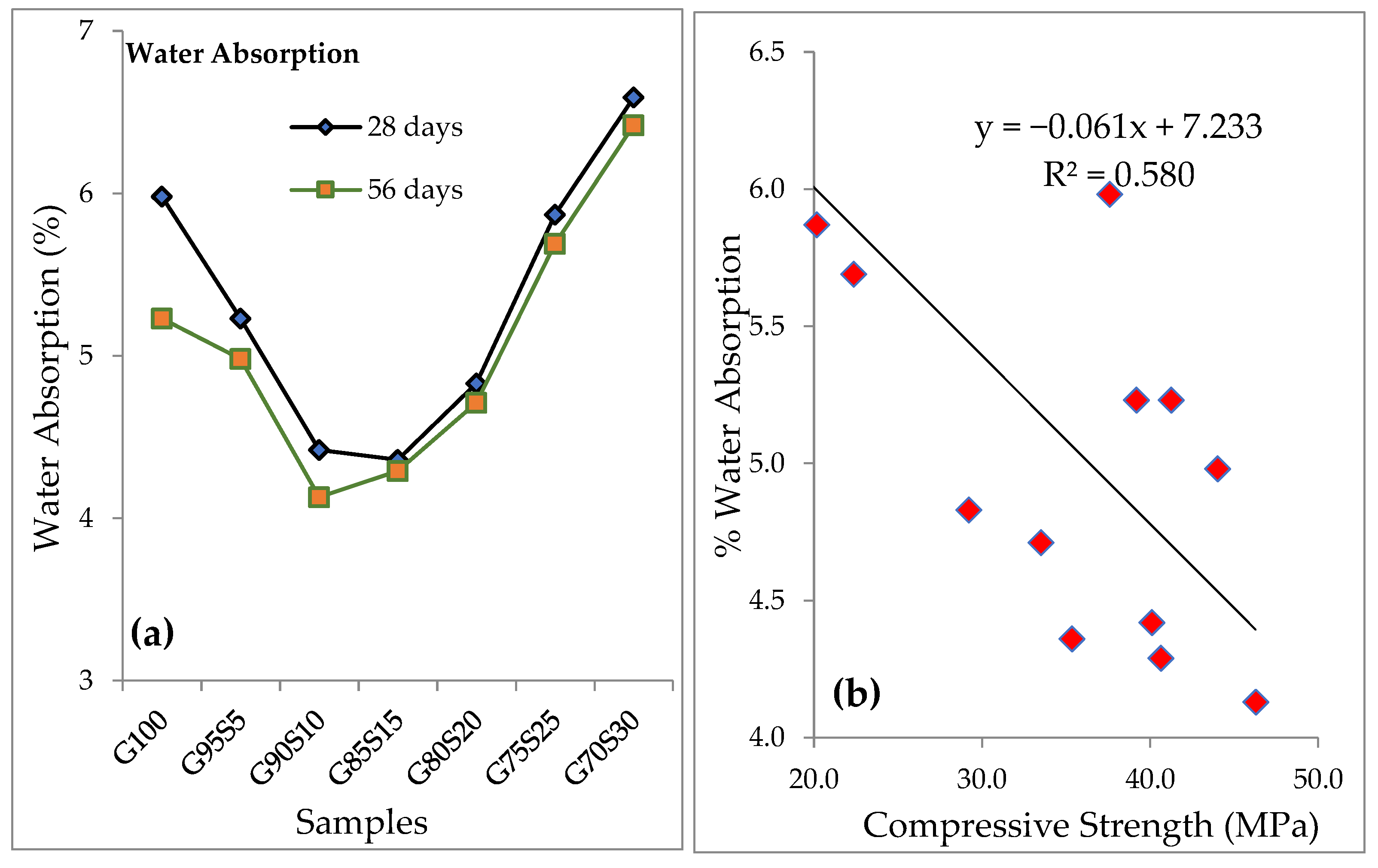Mechanical and Durability Characteristics Assessment of Geopolymer Composite (GPC) at Varying Silica Fume Content
Abstract
:1. Introduction
2. Materials and Methods
2.1. Materials
2.2. Mix Proportion
2.3. Methodology
2.4. Testing
3. Results and Discussions
3.1. Mechanical Strength
R2 = 0.9681
3.2. Ultrasonic Pulse Velocity (UPV)
R2 = 0.9665
3.3. Acid Attack
3.4. Rapid Chloride Ion Permeability Test
R2 = 0.9208
3.5. Water Absorption
R2 = 0.5804
4. Conclusions
- The mechanical strength of geopolymer composite increased with an increase in percentage silica fumeup to 10% content in geopolymer mix. The regression curve and data points showed a good correlation of compressive and split tensile strength;
- The measure of change in water absorption was found to be decreasing with an increase in silica fume content up to 10% in the mix.
- The incorporation of silica fumes up to 10% in GPC resulted in a maximum reduction in chloride ion penetration.
- A noteworthy difference was observed in mass loss and strength loss of the GPC with 100% GGBS and specimens with silica fume when they were exposed to the acidic environment. GPC with 15% silica fume (G85S15) performed better than 100% GGBS (G100).
- In the case of durability properties, the regression curve and data points showed a good correlation of compressive strength with RCPT, water absorption, and UPV values.
Author Contributions
Funding
Institutional Review Board Statement
Informed Consent Statement
Data Availability Statement
Conflicts of Interest
References
- Gao, T.; Shen, L.; Shen, M.; Chen, F.; Liu, L.; Gao, L. Analysis on differences of carbon dioxide emission from cement production and their major determinants. J. Clean. Prod. 2015, 103, 160–170. [Google Scholar] [CrossRef]
- Davidovits, J. Geopolymers. J. Therm. Anal. 1991, 37, 1633–1656. [Google Scholar] [CrossRef]
- Aghaeipour, A.; Madhkhan, M. Effect of ground granulated blast furnace slag (GGBFS) on RCCP durability. Constr. Build. Mater. 2017, 141, 533–541. [Google Scholar] [CrossRef]
- Lee, J.; Lee, T. Durability and Engineering Performance Evaluation of CaO Content and Ratio of Binary Blended Concrete Containing Ground Granulated Blast-Furnace Slag. Appl. Sci. 2020, 10, 2504. [Google Scholar] [CrossRef] [Green Version]
- Park, B.; Choi, Y. Evaluation of Autogenous Healing in Flexural Mortar Members by Chloride Ion Penetration Resistance. Nanomaterials 2021, 11, 1622. [Google Scholar] [CrossRef]
- Yuksel, I. Blast-furnace slag. In Waste and Supplementary Cementitious Materials in Concrete; Elsevier Ltd.: Amsterdam, The Netherlands, 2018; pp. 361–415. [Google Scholar] [CrossRef]
- Sivasundaram, V.; Malhotra, V.M. Properties of Concrete Incorporating Low Quantity of Cement and High Volumes of Ground Granulated Slag. ACI Mater. J. 1992, 89, 554–563. [Google Scholar] [CrossRef]
- Pavía, S.; Condren, E. Study of the Durability of OPC versus GGBS Concrete on Exposure to Silage Effluent. J. Mater. Civ. Eng. 2008, 20, 313–320. [Google Scholar] [CrossRef]
- O’Connell, M.; McNally, C.; Richardson, M.G. Performance of concrete incorporating GGBS in aggressive wastewater environments. Constr. Build. Mater. 2012, 27, 368–374. [Google Scholar] [CrossRef]
- Bhalla, N.; Sharma, S.; Sharma, S.; Siddique, R. Monitoring early-age setting of silica fume concrete using wave propagation techniques. Constr. Build. Mater. 2018, 162, 802–815. [Google Scholar] [CrossRef]
- Elyamany, H.E.; Elmoaty, A.E.M.A.; Diab, A.R.A. Sulphuric Acid Resistance of Slag Geopolymer Concrete Modified with Fly Ash and Silica Fume. Iran. J. Sci. Technol. Trans. Civ. Eng. 2020. [Google Scholar] [CrossRef]
- Kurtoğlu, A.E.; Alzeebaree, R.; Aljumaili, O.; Niş, A.; Gülşan, M.E.; Humur, G.; Çevik, A. Mechanical and durability properties of fly ash and slag based geopolymer concrete. Adv. Concr. Constr. 2018, 6, 345–362. [Google Scholar] [CrossRef]
- Okoye, F.N.; Prakash, S.; Singh, N.B. Durability of fly ash based geopolymer concrete in the presence of silica fume. J. Clean. Prod. 2017, 149, 1062–1067. [Google Scholar] [CrossRef]
- Esfe, M.H.; Wongwises, S.; Naderi, A.; Asadi, A.; Safaei, M.R.; Rostamian, H.; Dahari, M.; Karimipour, A. Thermal conductivity of Cu/TiO2-water/EG hybrid nanofluid: Experimental data and modeling using artificial neural network and correlation. Int. Commun. Heat Mass Transf. 2015, 66, 100–104. [Google Scholar] [CrossRef]
- Singh, P.K.; Rajput, S.K.; Kumar, S. Prediction of HAZ width and toughness of HY85 steel using artificial neural network. Adv. Mater. Process. Technol. 2020. [Google Scholar] [CrossRef]
- Aherwar, A.; Singh, A.; Patnaik, A. Prediction of effect of tungsten filled Co-30Cr-4Mo-1Ni metal matrix biomedical composite alloy on sliding wear peculiarity using Taguchi methodology and ANN. Adv. Mater. Process. Technol. 2017, 3, 665–688. [Google Scholar] [CrossRef]
- Karthikeyan, R.; Kumar, V.S.; Punitha, A.; Chavan, U.M. An Integrated ANN–GA Approach to Maximise the Material Removal Rate and Surface Roughness of Wire Cut EDM on Titanium Alloy. Adv. Mater. Process. Technol. 2020. [Google Scholar] [CrossRef]
- Shahmansouri, A.A.; Nematzadeh, M.; Behnood, A. Mechanical properties of GGBFS-based geopolymer concrete incorporating natural zeolite and silica fume with an optimum design using response surface method. J. Build. Eng. 2021, 36, 102138. [Google Scholar] [CrossRef]
- Mustakim, S.M.; Das, S.K.; Mishra, J.; Aftab, A.; Alomayri, T.S.; Assaedi, H.S.; Kaze, C.R. Improvement in Fresh, Mechanical and Microstructural Properties of Fly Ash-Blast Furnace Slag Based Geopolymer Concrete By Addition of Nano and Micro Silica. Silicon 2021, 13, 2415–2428. [Google Scholar] [CrossRef]
- BIS. IS 383: 1970 Specification for Coarse and Fine Aggregates from Natural Sources for Concrete; Indian Standard: Delhi, India, 1970; pp. 1–24. [Google Scholar]
- Venkatesan, R.P.; Pazhani, K.C. Strength and durability properties of geopolymer concrete made with Ground Granulated Blast Furnace Slag and Black Rice Husk Ash. KSCE J. Civ. Eng. 2016, 20, 2384–2391. [Google Scholar] [CrossRef]
- Blash, A.M.A.; Lakshmi, D.T.V.S.V. Properties of Geopolymer Concrete Produced by Silica Fume and Ground-Granulated Blast-Furnace Slag. Int. J. Sci. Res. 2016, 5, 319–323. [Google Scholar]
- Khedr, A.-Z.A.; Nagib, S.M. Characteristics of Silica Fume Concrete. J. Mater. Civ. Eng. 1995, 6, 357–375. [Google Scholar] [CrossRef]
- Duxson, P.; Provis, J.L.; Lukey, G.C.; Mallicoat, S.W.; Kriven, W.M.; van Deventer, J.S.J. Understanding the relationship between geopolymer composition, microstructure and mechanical properties. Colloids Surf. A Physicochem. Eng. Asp. 2005, 269, 47–58. [Google Scholar] [CrossRef]
- Bhanja, S.; Sengupta, B. Influence of silica fume on the tensile strength of concrete. Cem. Concr. Res. 2005, 35, 743–747. [Google Scholar] [CrossRef]
- Yao, W.; Jiang, S.; Fei, W.; Cai, T. Correlation between the Compressive, Tensile Strength of Old Concrete under Marine Environment and Prediction of Long-Term Strength. Adv. Mater. Sci. Eng. 2017, 2017, 8251842. [Google Scholar] [CrossRef] [Green Version]
- Vijayalakshmi, M.; Sekar, A.S.S.; Prabhu, G.G. Strength and durability properties of concrete made with granite industry waste. Constr. Build. Mater. 2013, 46, 1–7. [Google Scholar] [CrossRef]
- Demirboǧa, R.; Türkmen, I.; Karakoç, M.B. Relationship between ultrasonic velocity and compressive strength for high-volume mineral-admixtured concrete. Cem. Concr. Res. 2004, 34, 2329–2336. [Google Scholar] [CrossRef]
- Jindal, B.B.; Parveen; Singhal, D.; Goyal, A. Predicting Relationship between Mechanical Properties of Low Calcium Fly Ash-Based Geopolymer Concrete. Trans. Indian Ceram. Soc. 2017, 76, 258–265. [Google Scholar] [CrossRef]
- Rostami, M.; Behfarnia, K. The effect of silica fume on durability of alkali activated slag concrete. Constr. Build. Mater. 2017, 134, 262–268. [Google Scholar] [CrossRef]
- Zhang, S.P.; Zong, L. Evaluation of relationship between water absorption and durability of concrete materials. Adv. Mater. Sci. Eng. 2014, 2014, 650373. [Google Scholar] [CrossRef] [Green Version]






| S.N | Item | Silica Fume (%) | GGBS (%) |
|---|---|---|---|
| 1 | Silicon dioxide (SiO2) | 90.20 | 30.34 |
| 2 | Calcium oxide (CaO) | 0.75 | 32.79 |
| 3 | Magnesium oxide (MgO) | 0.40 | 7.75 |
| 4 | Aluminium oxide (Al2O3) | 1.10 | 14.11 |
| 5 | Ferric oxide (Fe2O3) | 1.38 | 2.83 |
| 6 | Sodium oxide (Na2O) | 0.29 | - |
| 7 | Titanium oxide (TiO2) | - | - |
| 8 | LOI | 2.9 | 0.26 |
| Designation | Slag (kg) | Silica Fume (kg) | Fine Aggregates (kg) | Coarse Aggregates (kg) | |
|---|---|---|---|---|---|
| 4.75–10 mm | 10–20 mm | ||||
| G100 | 370.6 | 0 | 655.3 | 461.9 | 692.8 |
| G95S5 | 352.1 | 18.5 | 653.7 | 460.7 | 691.1 |
| G90S10 | 333.5 | 37.1 | 652.1 | 459.6 | 689.4 |
| G85S15 | 315.0 | 55.6 | 650.4 | 458.4 | 687.6 |
| G80S20 | 296.5 | 74.1 | 648.8 | 457.3 | 685.9 |
| G75S25 | 277.9 | 92.7 | 647.1 | 456.1 | 684.2 |
| G70S30 | 259.4 | 111.2 | 645.5 | 455.0 | 682.5 |
| Soda Flakes (kg) | Distilled Water (kg) | Sodium Silicate (kg) | |
|---|---|---|---|
| Quantity | 23.72 | 49.41 | 98.82 |
| Extra water (kg) | 116.3 | ||
| Na2SiO3/NaOH | 2 | ||
Publisher’s Note: MDPI stays neutral with regard to jurisdictional claims in published maps and institutional affiliations. |
© 2021 by the authors. Licensee MDPI, Basel, Switzerland. This article is an open access article distributed under the terms and conditions of the Creative Commons Attribution (CC BY) license (https://creativecommons.org/licenses/by/4.0/).
Share and Cite
Gupta, A.; Gupta, N.; Saxena, K.K. Mechanical and Durability Characteristics Assessment of Geopolymer Composite (GPC) at Varying Silica Fume Content. J. Compos. Sci. 2021, 5, 237. https://doi.org/10.3390/jcs5090237
Gupta A, Gupta N, Saxena KK. Mechanical and Durability Characteristics Assessment of Geopolymer Composite (GPC) at Varying Silica Fume Content. Journal of Composites Science. 2021; 5(9):237. https://doi.org/10.3390/jcs5090237
Chicago/Turabian StyleGupta, Ankur, Nakul Gupta, and Kuldeep Kumar Saxena. 2021. "Mechanical and Durability Characteristics Assessment of Geopolymer Composite (GPC) at Varying Silica Fume Content" Journal of Composites Science 5, no. 9: 237. https://doi.org/10.3390/jcs5090237







